A few weeks ago while in Arizona I visited Taliesin West, arguably the most well known site in the area. Frank Lloyd Wright started the 'camp' in 1937 when his doctor suggested spending the winters in the southwest for his health. He would winter here until his death in 1959.
Frank Lloyd Wright fell in love with the desert landscape overlooking Paradise Valley just north of Scottsdale. It's easy to see why; still stunning.
Unlike many modernist architects Wright loved art and decoration and dotted his campus with items from his collection of Asian art as well as these Native American carvings above found on site.
At the time Wright was operating an architecture school and used his students as indentured servants of sorts. The students did the construction: collecting the stones on site and building the formwork to erect the structures on 'campus'. This might have been seen as slightly unfair but was a marvelous education for these young architects ( win win? ). Above you see a corner of his office; the glass was a later addition (originally canvas was used in place of glass for the 'windows'.
Say what you will about Frank Lloyd Wright (most over-rated architect ever?) but the man was inventive. Forms and buildings like these were straight out of his imagination and unlike anything else at the time and have stood the test of time.
While on the topic, architects and designers love to roll their eyes at the name of Wright partly because he has become such an (overblown) icon. He is the only architect that the average person could probably name! I think we need to give credit where it is due. Wright may not be the ONLY great architect but he certainly was one of the most important designers of the 20th century. The cult-like status awarded to him is bizarre but I can at least see the reasoning.
The campus faces the valley stretched out before it with a small lawn and pool - an oasis in the desert.
Above to the left you see the architecture studio (still in use by students )with his own house / quarters to the right. His office we saw earlier in the post is to the far left.
Another piece of Asian art incorporated into the landscape above.
And here we see Wright's favorite view in the world of Paradise Valley down to Scottsdale (until the power lines were installed!). Wright lobbied to have them removed but nothing could be done.
The foundation still has an on-site sculptor (former student of Wrights) and her work dots the campus.
I love the way the buildings work with the surrounding landscape. Above another fountain stands between Wrights private quarters and the screening room.
You heard that correctly, screening room! Wright was a huge movie buff; his son was a Hollywood agent and his granddaughter was Anne Baxter! And as a precursor to current design the 'tv' ( or projector screen rather) was above the fireplace. The room also boasts this intriguing ceiling and coved lights.
This breezeway between Wrights quarters and the architecture school beautifully frames the view.
Above to the left is the screening room with Wright's quarters on the right.
This intriguing bell tower announced meal times.
I just fell in love with the desert landscape and can see the draw for Wright.
Fountains and water create little oasis pockets throughout the garden.
The lines of the buildings echo the lines of the desert floor - harking back to Wright's Prairie style.
Art works are to be found throughout the garden.
I loved this quote from Chinese philosopher Laotse on the walls of the theater / gathering space: "The reality of the building does not consist in roof and walls but in the space within to be lived in"; A statement that's easy to forget in the planning and design of a building.
All of the fountains attracted bees and other desert wildlife -always a surprise!
The most interesting building on campus was the cabaret - still in frequent use. Wright designed it in the shape of a hexagon to have perfect acoustics and to my untrained ear they were pretty amazing.
Mrs. Wright strung the uncharacteristic Christmas lights along the ceiling but they are a nice touch. I'm sure Wright would be appalled! All of the other fixtures and furniture in the room were custom designed by him.
I hope you enjoyed this brief look at Taliesin West through my eyes. For more pictures (special privileges much?) check out the blog of Martha Stewart who was allowed to take photos in areas that we weren't right around the same time I visited! If you find yourself in the Phoenix / Scottsdale area make sure to check out Taliesin West!
Wednesday, March 26, 2014
Frank Lloyd Wright's Taliesin West
Labels:
Architect,
architects,
Arizona,
art,
desert landscape,
Frank Lloyd Wright,
Gardens,
Interiors,
Phoenix,
Scottsdale,
travel
Subscribe to:
Post Comments (Atom)























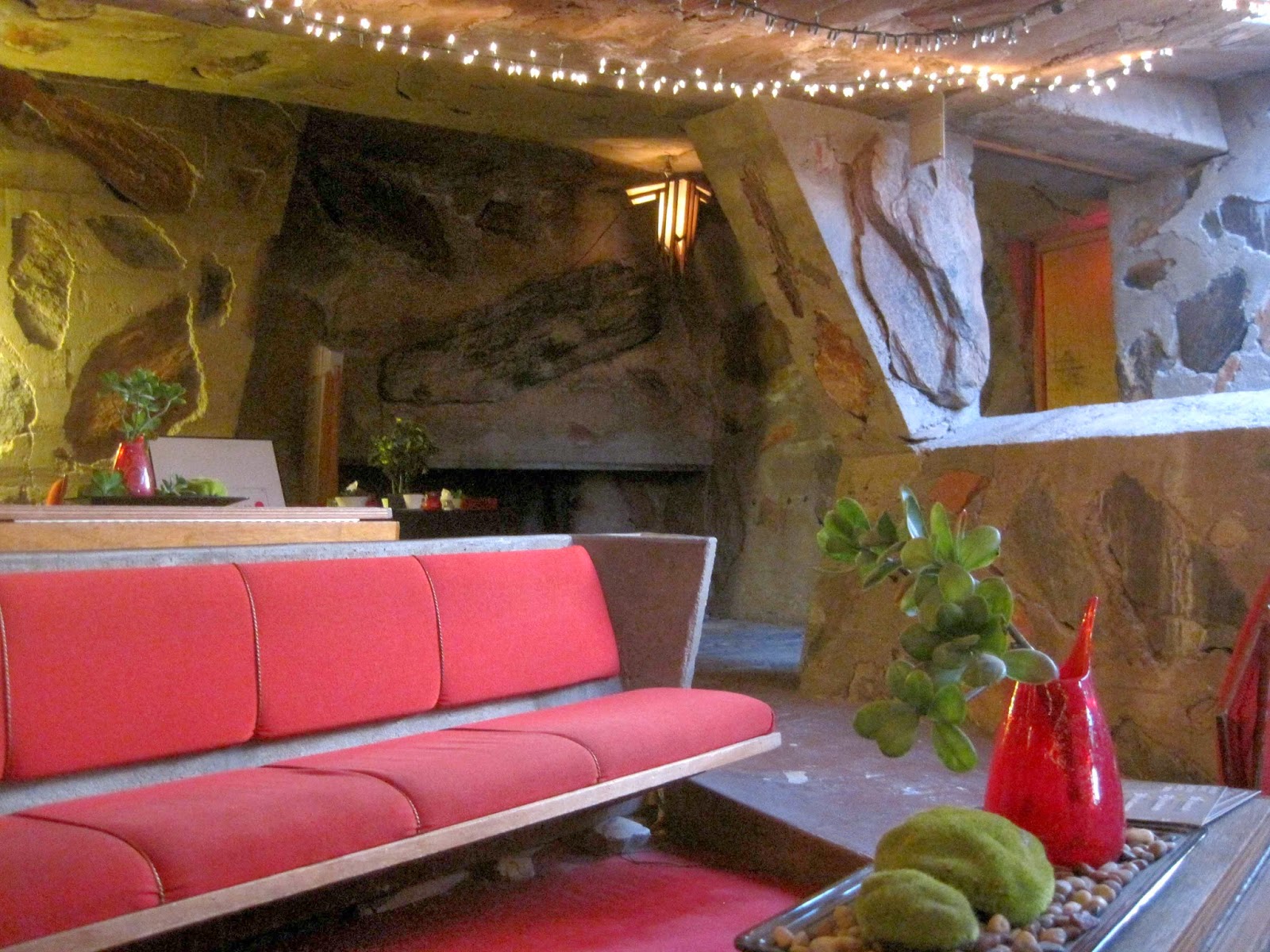



















.jpg)























.JPG)



























































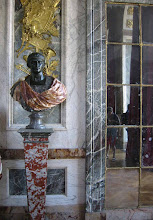


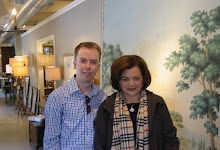






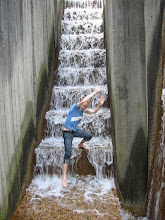

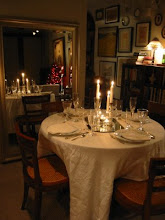
12 comments:
I've always heard about Taliesin West but, as all this seemed new to me, I guess I'd never actually seen much of it. Not my cup of tea at all - so much crusty concrete and things sticking out at strange angles, and the walls with chunks of rock stuck into it, to me resemble nothing more than unnaturally enlarged slices of panettone - but I do have to credit his imaginative zeal and audacity. And I expect it is more congenial in person...? I've often experienced structures that, from a distance, looked like the devil, but were very pleasant to live in and around. And that's certainly nothing to discount. : )
Stephilius -I know precisely what you mean and agree! However, I think it does fit the context and in person is much nicer than you'd expect. Also this wasn't year round living -they were only here 3 months of the year and on top of that, if you go to the Martha Stewart website link, the interiors of Wright's own apartment is actually quite finished, comfortable, and lovely. I guess he saved these unusual spaces for areas not actually 'lived in'.
Wasn't Wright the first American architect whose work, as it were, crossed the Atlantic? One could say that before Wright all American architecture was of
European origin – think of all the Beaux Arts architects trained in France, for example, and the then-new Colonial Revival, the Queen Anne Revival, the Gothic Revival, etc. Wright broke with all that and when I say his work crossed the Atlantic I mean that the early Modernists took note of what he was doing and were influence by him.
Yes, the cult is overblown and much cant is both spoken and written – I agree with you all the way.
I like your pictures better than Marthas!
It is an amazing place with so many zillions of objects to draw your attention(fire breathing dragon?). I have never seen it in person. I imagine the whole experience would be insane since it was designed so organically. It's like an architectural being thats organic and breathing with life.
Thanks for the great tour!
Blue, I'm not sure if his work was the first to cross the Atlantic but I wouldn't be surprised. Standford White perhaps? What architect did Elsie de Wolfe use, etc.... intriguing question!
Deana,
I think you summed it up better than I could -the amazing thing about the place can't be captured in a photograph. It's being cocooned inside a totally designed space which blends seamlessly with it's environment. The actual tectonics might not appeal to everyone but the environment created is sublime or at least 'special'.
Unfortunately the fire breathing sculpture wasn't (doesn't?) working but it would have been something really cool to see!
I loved the dragon lantern! It's wired for gas, so that when it's lit, it breathes fire!
Meg - such a shame they don't keep it running!
What a wonderful site...no wonder La .vreeland herself posed on the roofline in Toreador style for VOGUE in the last century! Fire breathing dragons, Chinese glazed potteries imbedded, if you really step back...some areas have the silhouette of an Asian Temple arising out of Paloeithic sheets of earth layered upon each other as if shorn by an earthquake.
Stanford White copied Europe but Richard Morris Hunt with Alva Vanderbilt began the movement of Classical Architecture in America.
FLW Is THE MASTER architect of the 20thC, no one can claim this, even Gehry must lay his vision as a laurel wreath at the feet of FLW - Neutra and Schindler came across the Atlantic to work for him after becoming entranced by his visions...to found their beginning abode on KINGS ROAD in West Hollywood, a masterful offshoot inspired by Wright! They even followed to Japan for the Imperial Hotel in Tokyo. Japan gave much to FLW towards a futuristic silhouette...with some pre-revolutionary visits to China I am sure.
A FORBIDDEN PALACE with all its pavilions and minions still to this day...The Last Emperor.
I remember visiting Taliesin West in 1964, five years after Wright's death, and seeing young students there who probably had studied directly under him. It's amazing to think that when Wright was middle-aged, with his career in shambles, many people considered him a 19th-century architect.
I have to admit that his design depresses me. That being said, I agree with your sentiment that he was certainly original. :)
xo
Andie
I visited today.
It was fascinating.
Post a Comment